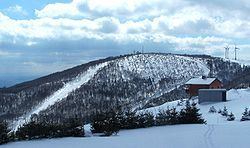Elevation 869 m | ||
 | ||
Similar Komáří hůrka, Klínovec, Plešivec, Stropník, Loučná | ||
The Bouřňák (German: Stürmer which means "Stormer") is one of the highest mountains in the eastern Ore Mountains on the territory of Czech Republic. The mountain is known as one of the most important ski centres of the Eastern Ore Mountains. The windswept beech forest on the northeast side of the summit, an area of 3.26 hectares, has been placed under protection since 1979 as a natural monument.
Contents
- Map of BouC599C588C3A1k 417 81 Moldava Czechia
- HistoryEdit
- Origin of the nameEdit
- ViewsEdit
- Location and surrounding areaEdit
- Routes to the summitEdit
- Mountain Rescue Service stationEdit
- References
Map of Bou%C5%99%C5%88%C3%A1k, 417 81 Moldava, Czechia
HistoryEdit
The foundation stone for the mountain hut was laid on 15 July 1928. It was built by the Czech Tourist Club (KČT). It was used by the Wehrmacht in the Second World War.
Origin of the nameEdit
The German and Czech name of the mountain comes from the severe storms (Czech bouře, German Sturmer) that occur here.
ViewsEdit
The views are very rewarding. To the north it is somewhat obscured by the crest of the Ore Mountains, but the views to the south, east and west are impressive. Over 206 towns and villages may be seen from the summit, from Ústí to Most. In the distance Ještěd, Říp in front of Prague, the Křivoklátsko Woods, the Doupov Mountains and Kahleberg may be made out.
Location and surrounding areaEdit
The Bouřňák lies in the eastern Ore Mountains, 10 kilometres northwest of Teplice and 10 kilometres southwest of Altenberg on a prominent escarpment of the Ore Mountains. At the foot of the mountain is the mining town of Mikulov and the village of Hrob. Immediately next to the shoulder of the mountain, on the crest of the Ore Mountain ridge, is the small settlement of Nové Město, today purely a resort.
Routes to the summitEdit
Mountain Rescue Service stationEdit
The Mountain Rescue Service of the Czech Republic has its rescue station on the peak. It is permanently open. During the week, the station is occupied by full-time employees; at weekends, volunteers help with rescue duties.
